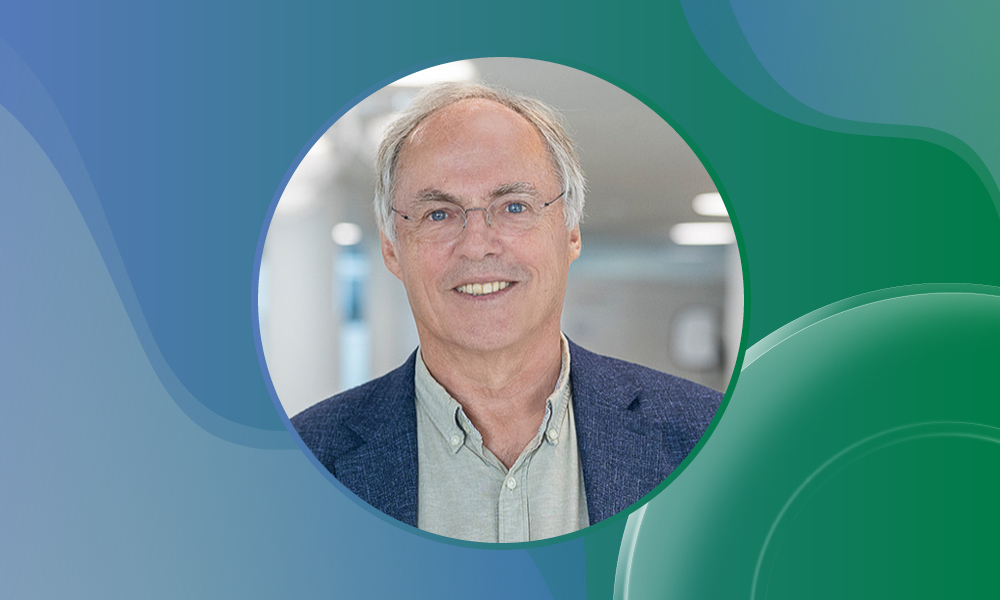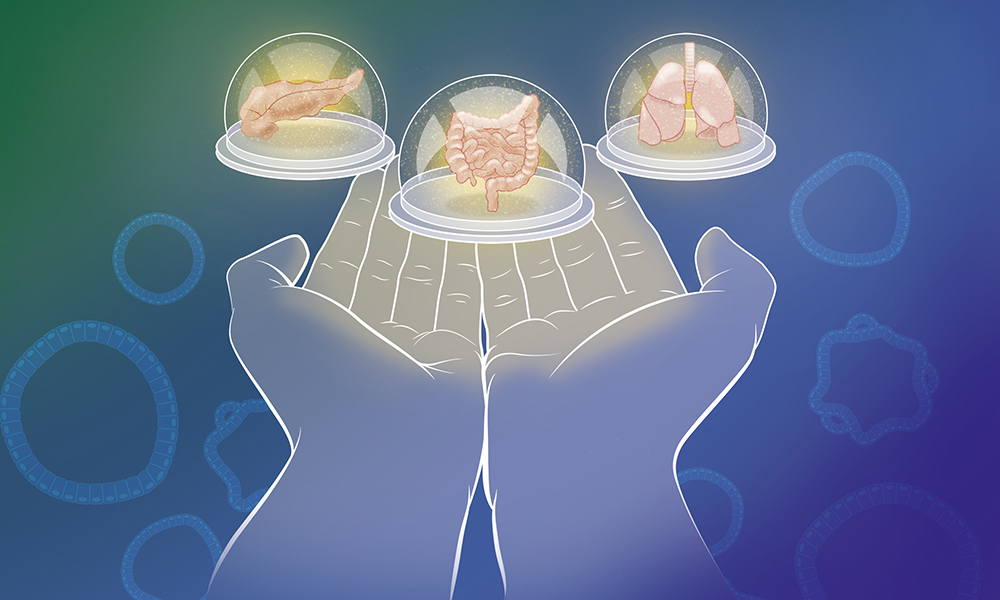
The importance and limitations of organoids
Hans Clevers, the 2024 Kafatos Lecturer, shares thoughts on organoids, personalised medicine, drug development, and the importance of researchers going outside their ‘comfort zones’

Often referred to as the ‘Father of Organoids’, Hans Clevers is a molecular geneticist, cell biologist, and stem cell researcher who has never shied away from trying something new.
Perhaps exemplifying this, one of his attempts to grow ‘healthy cells’ in the lab (instead of cancer cells, as was the norm in the 1990s) led to the first organoid – three-dimensional cell aggregates that can resemble miniature organs. The experience, as he shares, reinforced his belief that scientists must trust themselves and those around them to take calculated risks that help make big discoveries.
Clevers, who is this year’s EMBL Kafatos lecturer and who is currently Head of Pharma, Research and Early Development, and a member of the Corporate Executive Committee, of the Swiss healthcare company Roche, will talk about organoids, personalised medicine, and drug development at the Royal Netherlands Academy of Arts and Sciences in Amsterdam on Friday, 4 October at 18:00 CEST. His lecture, titled ‘Organoids: Avatars of Human Organs in Health and Disease’, will also be streamed online, making it accessible to a global audience in addition to those attending in person at the prestigious Dutch venue.
A brief chat with Clevers provided some background on his ground-breaking research that has offered new ways to study disease, develop therapeutics, and find customised approaches to medicine. The following is but a portion of that discussion.
What led to creating your first organoid?
In the 1990s, we made a number of chance discoveries about a signalling pathway called the Wnt pathway and linked it to cancer. We were the first to link this pathway to stem cells, and we realised it played a key role in the gut’s lining, specifically the epithelium, the most rapidly self-healing tissue in the human body. Every seven days, it replaces itself – a process driven by stem cells. Wnt, it turns out, drives these stem cells. At the same time, we realised that cancer in the gut is also driven by the same pathway. The mutations in colon cancer activate the very same signals that the normal stem cells use, but we wanted to understand the stem cells better.
We discovered these stem cells, and they were so active – we had been able to observe them live with a fluorescent protein tracker – that we wondered if we could have them continue this activity in the lab. At that time, it was generally believed that normal cells wouldn’t grow in a dish; only cancer cells grew in this artificial environment. It’s very unnatural, and even cancer cells have had to adapt to it.
But, I found a partner in Toshiro Sato, a gastroenterologist at Keio University School of Medicine in Tokyo. We wanted to grow cells in 3D – so no plastic. Real cells grow in 3D in collagen, and we wanted to grow these stem cells as if they were in a normal body.
Toshiro decided to use this magical collagen-like stuff, known as Matrigel. A gelatinous protein mixture, Matrigel mimicked the environment found in many tissues, which made it perfect.
To our surprise, It worked right away. We put one stem cell in, and rather than making lots of stem cells – which was all we had hoped to do – it actually made these miniature guts. This was the basis for a paper in 2009. I think this was the first example of growing tissue stem cells outside the body like this.
The question we had at the time, however, was whether we had created something just for our gut experiments, or had we discovered something bigger. It boiled down to finding cells from different parts of the body expressing LGR5, a marker found on certain stem cells that help repair tissues and make new cells. These days, it’s possible to grow any human organ as a ‘mini’ organ in a dish.
Were you the first to create these organoids?
Yes, but…there are two types of organoids – the ones we invented using stem cells from specific parts of the body and those derived from induced pluripotent stem cells (iPSCs) or islet cells. Japanese scientist Yoshiki Sasai developed these other organoids at roughly the same time we were doing our work. I always think he is at least half ‘father’ to this technology.
Those iPSC-derived organoids require complex sets of instructions to grow, so it’s a more complicated approach. However, you can’t grow a brain organoid with our approach because there are no suitable stem cells in your brain to seed it. Sasai’s approach can build a piece of brain tissue after a three-to-five-month procedure that mimics normal development.

Where has your organoid research taken you?
Our work led to personalised medicine. Theoretically, you can make a disease model for every patient, and that has worked very well for studying cystic fibrosis. Around 2014, a very popular cystic fibrosis drug seemed to help half of the cystic fibrosis patients with a particular mutation of the disease. However, we didn’t know if it helped those with other mutations as well because those other mutations had no test nor clinical trial to get that answer.
So, we set up a simple organoid test where we could build organoids and have results in one to two weeks. If the drug treated a particular cystic fibrosis mutation in the organoid, we would know the drug worked in the patients as well.
Your work has also involved other medical issues. Tell us more.
Many papers now show we can subject organoids to the same things as patients and use them as avatars or models. In the case of a drug-resistant bacterial infection, you can test bacteria against a number of antibiotics using organoids from a specific patient. You find the one that kills the bacteria, and this way, you know – before the patient even gets the drug – that it can kill the pathogen.
We figured that because we can grow normal tissue, it should be easy to grow cancer cells this way too. There are now 50 or 60 papers that have essentially followed patients in the clinic and found that organoid test results of chemotherapy drugs were predictive of clinical outcomes. However, clinical guidelines that doctors follow to treat patients still make more sense. Any new diagnostic approach like this needs a lot more validation before it can be used widely as standard medical procedure.
With the thousands of cancer patients that hospitals treat each year with proven therapies, industry hasn’t gotten to the tipping point to build technology for this kind of diagnostic test on a large scale – especially when in most cancer cases, standard treatments work. As a diagnostic test, it’s still expensive and requires specialised skills.
How do organoids change the way biologists can do research?
Animal research subjects have often posed ethical issues and are not always the best predictors, so there’s a big effort to see where and how we can use organoids instead of animal models. Everything we study with animals can probably be done better with human organoids and more safely in the future.
The traditional drug development process has many steps, and at every step, we use animals or cell lines of animals to measure a potential therapeutic’s safety and effectiveness. Additionally, animal models are not very telling for safety toxicity. We also know that for something like chronic inflammatory diseases, such as inflammatory bowel disease and rheumatoid arthritis – animals can display the symptoms, but they don’t have the disease.
However, organoids are still a reductionist system. If you’re using a liver organoid, for example, there’s no brain attached to it. You’re not going to get a sense of the impacts on hormones, blood pressure, and glucose levels, for example. Organoids are not a replacement for later-stage human drug trials. It would be very arrogant to state that they replace an entire organism, but it’s a great first filter in research.
Are there other benefits to using organoids in medical research?
With human organoids, you can capture the diversity of humans. We can incorporate people of different ages, genders, and ethnicities, and the results can actually yield huge variations. It really surprised me when we started doing this, how organoids were able to capture so many differences between individuals. We have been able to build biobanks of 50 or 100 individuals – in the case of cystic fibrosis, we now have 500. For colon cancer, we’re at 500-600.
Getting to a more personal side of things, what has been your career path?
When I was about 4 years old, we moved from Eindhoven, Netherlands, to a little village outside of the city. Even then, I’d tell my teachers that I wanted to be a biologist. I was always reading about nature and about discoveries, and I have always known I wanted to be a researcher.
In 1975, at age 18, I left this little village and went to university at Utrecht, and I was extremely disappointed. In 19th-century buildings, where we’d wear coats inside in the windy, cold winter, the curriculum was all about memorising Latin name taxonomy. Nothing interesting. It wasn’t like chemistry or physics where those students developed a deep understanding of their fields. So, I switched to medical school, and I found myself drawn to the hospital’s social environment. I actually had a training position in paediatrics, so I could have been a paediatrician.
Obviously, I didn’t continue in that direction. That’s partly because of experiences I had in Nairobi, Kenya, and the United States. In 1981, monoclonal antibodies had just been invented to use against African trypanosomiasis – sleeping sickness –and I went to Nairobi and was involved with this work. Tsetse flies transmit this sleeping sickness to humans when they bite, having acquired the parasites themselves from infected humans or animals. In the US, I did a summer research rotation at the National Institutes of Health.
Because of these experiences, I was told I should get a PhD while also training as a paediatrician. I’d then have a unique double background. After stepping out for a year and publishing enough papers to get a thesis, however, I realised, “no, I’m really a scientist.”
What are your guiding principles or mantras that have provided direction throughout your career?
Early on, I learned from my thesis advisor that sharing and trust are really important. Trust yourself. Trust the people around you. Trust your collaborators.
And also share what information you have. This sharing will pay you back tenfold. It also makes the work much, much nicer.
Courage is also important. I moved my lab from working only on immunology to working on flies, frogs, and worms and then on guts. Now we work on all organs. If you know something well – a particular technique – have the courage to actually move into another field where that expertise would bring something new. Find a good collaborator and see where it takes you. I think it’s a mistake to spend your entire life working on one molecule, for example. I think we should all be open to moving in new directions.
Not enough scientists do this, and often if you bring your expertise to new fields, you bring a new perspective and likewise, the new field brings something to you.
The Kafatos Lecture series, inaugurated in 2021, brings groundbreaking and socially relevant life sciences research to the worldwide public, seeking especially to inspire young scientists and students.
The Bodossaki Foundation once again provides support for this year’s lecture.


